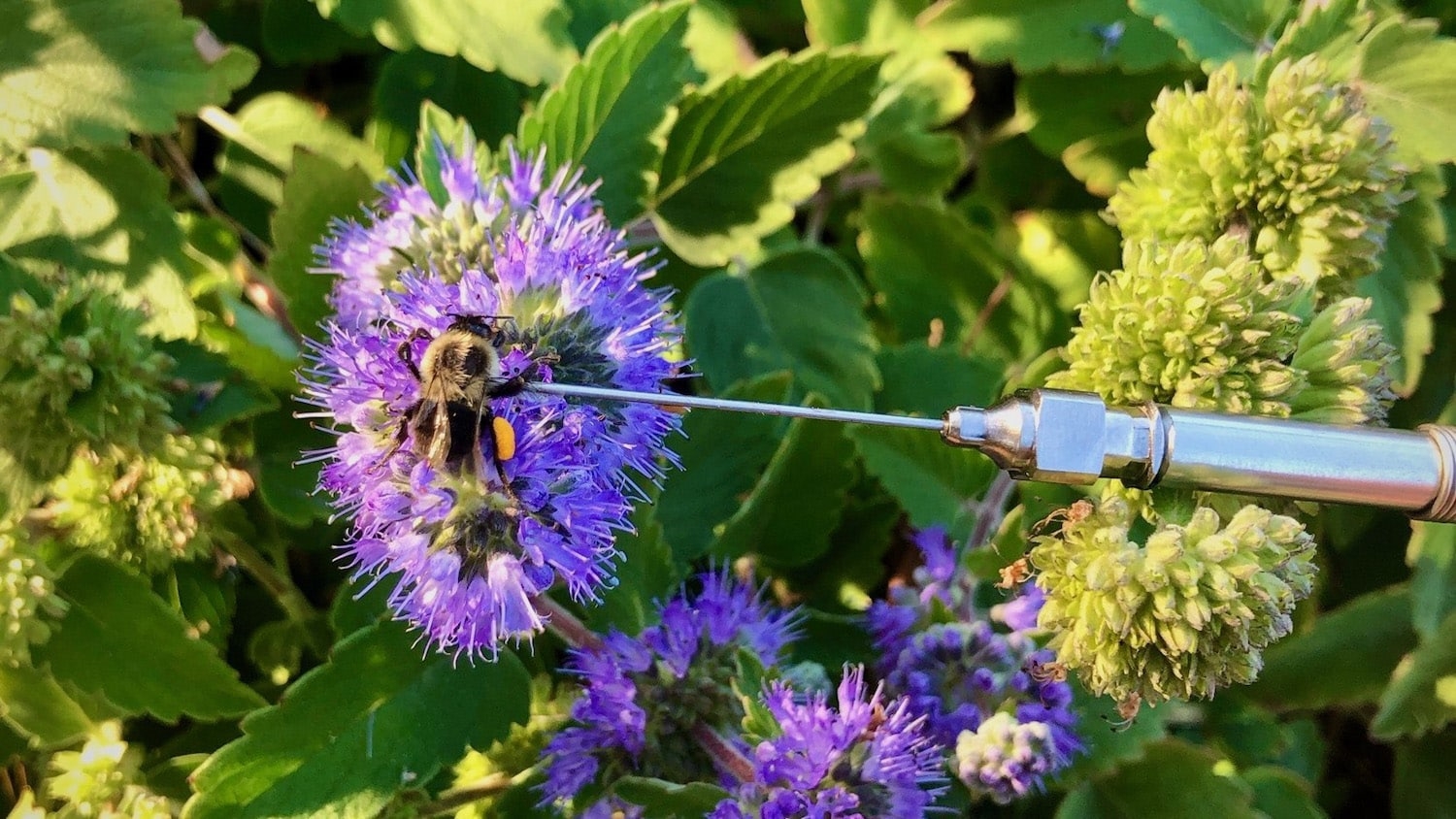Study Finds Carrying Pollen Heats Up Bumble Bees, Raising New Climate Change Questions

A new study from North Carolina State University finds carrying pollen is a workout that significantly increases the body temperature of bumble bees. This new understanding of active bumble bee body temperatures raises questions about how these species will be impacted by a warmer world due to climate change.
Spend a bit of time at a nearby flower patch and you will spot a fuzzy bumble bee with yellow bumps on her back legs. These yellow bumps are solid packets of pollen that have been carefully collected during the bees’ foraging trip for transport back to their nests. And while bees may seem to move from flower to flower with ease, these pollen packets can weigh up to a third of their body weight. This new study found that – after accounting for environmental temperature and body size – the body temperature of bumble bees carrying pollen was significantly hotter than the temperature of bees that were empty-legged.
Specifically, the researchers found that bee body temperatures rose 0.07°C for every milligram of pollen that they carried, with fully laden bees being 2°C warmer than unladen bees.
Like ants and other ectotherms, the body temperature of a bumble bee is mostly determined by the environment. Among bees, bumble bees are exceptionally cold tolerant and will shiver to warm up during cold days. However, not much is known about how they can tolerate heat. Since pollen-laden bumble bees are hotter than unladen ones, this could mean that carrying a full load of pollen on a hot day puts bees at greater risk of reaching the potentially lethal end of their temperature tolerance.
“Getting warmer from carrying pollen could put bumble bees in the range of those stressful, critically hot temperatures,” says Malia Naumchik, a former applied ecology minor undergraduate and lead author of the study. “This has important implications for bumble bees and climate change. As environmental temperatures increase, the bees’ operational range of temperatures could shrink significantly.”
Bumble bee numbers and species diversity is on the decline across the world, particularly in areas that are warming up due to climate change. But the exact mechanics of how climate change is impacting bumble bees are not yet fully understood. This finding could be one piece of that puzzle.
Pollen is crucial for every stage of a bumble bee’s life history. Newly emerged queens in the spring need to feed themselves and then feed their sister workers. Those workers then take over feeding the colony, larvae and future queens. Without pollen, or enough pollen, colonies will not thrive – risking future colonies and the species as a whole. This may also have implications for pollination in general, and could impact agriculture and ecosystems alike.
“We need to know how bumble bees may change their behavior, to better understand how this could affect how much pollen they collect and how much pollination they perform during hot days,” says Elsa Youngsteadt, a professor in applied ecology and supervisor of Malia’s research. “Whether it’s carrying smaller loads of pollen or foraging for shorter times, it could result in less pollen coming to the colony and fewer plants being pollinated. This is particularly important since bumble bees provide critical ecosystem services and are key pollinators for agriculture, especially in the United States and Europe.”
The paper, “Larger pollen loads increase risk of heat stress in foraging bumblebees,” is published in Biology Letters. This study was supported by North Carolina State University, USDA National Institute of Food and Agriculture award #2020-67013-31916, and USDA National Institute of Food and Agriculture Hatch Project #1018689.
-jewell-
Note to editors: The study abstract follows.
“Larger pollen loads increase risk of heat stress in foraging bumblebees”
Authors: Malia Naumchik, Elsa Yougsteadt, North Carolina State University
Published: May 17, Biology Letters
DOI: 10.1098/rsbl.2022.0581
Abstract: Global declines in bumblebee populations are linked to climate change, but specific mechanisms imposing thermal stress on these species are poorly known. Here we examine the potential for heat stress in workers foraging for pollen, an essential resource for colony development. Laboratory studies have shown that pollen foraging causes increased thoracic temperatures (Tth) in bees, but this effect has not been examined in bumblebees nor in real-world foraging situations. We examine the effects of increasing pollen load size on Tth of Bombus impatiens workers in the field while accounting for body size and microclimate. We found that Tth increased by 0.07°C for every mg of pollen carried (p = 0.007), resulting in a 2°C increase across the observed range of pollen load sizes. Bees carrying pollen were predicted to have a Tth 1.7-2.2°C hotter than those without pollen, suggesting that under certain conditions, pollen loads could cause B. impatiens workers to heat from a safe Tth to one within the range of their critical thermal limits we measured (41.3°C to 48.4°C). Bumblebees likely adopt behavioral or physiological strategies to counteract the thermal stress induced by pollen transport, and these may limit their foraging opportunities as environmental temperatures continue to increase.
This post was originally published in NC State News.